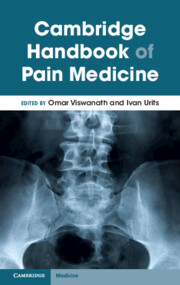Book contents
- Cambridge Handbook of Pain Medicine
- Cambridge Handbook of Pain Medicine
- Copyright page
- Contents
- Contributors
- Pain Handbook Introduction
- Part I Introduction to Pain: Pain Signaling Pathways
- Part II Common Categories of Pharmacologic Medications to Treat Chronic Pain
- Part III Chronic Pain Conditions Head and Neck
- Part IV Spine
- Part V Extremities
- Chapter 18 Carpal Tunnel Syndrome
- Chapter 19 Adhesive Capsulitis of the Shoulder
- Chapter 20 Thoracic Outlet Syndrome
- Chapter 21 Osteoarthritic Hip Pain
- Chapter 22 Osteoarthritic Knee Pain
- Chapter 23 Chronic Ankle and Foot Pain
- Chapter 24 Plantar Fasciitis
- Chapter 25 Phantom Limb Pain
- Part VI Misc
- Part VII Adjunctive Therapy
- Index
- References
Chapter 19 - Adhesive Capsulitis of the Shoulder
from Part V - Extremities
Published online by Cambridge University Press: 01 December 2023
- Cambridge Handbook of Pain Medicine
- Cambridge Handbook of Pain Medicine
- Copyright page
- Contents
- Contributors
- Pain Handbook Introduction
- Part I Introduction to Pain: Pain Signaling Pathways
- Part II Common Categories of Pharmacologic Medications to Treat Chronic Pain
- Part III Chronic Pain Conditions Head and Neck
- Part IV Spine
- Part V Extremities
- Chapter 18 Carpal Tunnel Syndrome
- Chapter 19 Adhesive Capsulitis of the Shoulder
- Chapter 20 Thoracic Outlet Syndrome
- Chapter 21 Osteoarthritic Hip Pain
- Chapter 22 Osteoarthritic Knee Pain
- Chapter 23 Chronic Ankle and Foot Pain
- Chapter 24 Plantar Fasciitis
- Chapter 25 Phantom Limb Pain
- Part VI Misc
- Part VII Adjunctive Therapy
- Index
- References
Summary
Adhesive capsulitis is a common cause of shoulder pain and disability, affecting nearly 2% of the general population. It is present in approximately 20% of all diabetics, highly correlated with several other systemic conditions and predispositions, yet is still idiopathic in etiology. Diffuse, insidious onset of shoulder pain with no known trauma is seen in early disease, while symptoms of later disease are dominated by a progressive stiffening that restricts multiple planes of movement. Adhesive capsulitis is primarily managed conservatively with oral anti-inflammatories, local injections, and physical therapy, and the majority of patients achieve spontaneous resolution of symptoms within one to three years. While not conclusively superior to less invasive measures, manipulation under anesthesia and arthroscopic capsulotomy are viable alternatives to patients refractory to conservative therapies.
- Type
- Chapter
- Information
- Cambridge Handbook of Pain Medicine , pp. 146 - 156Publisher: Cambridge University PressPrint publication year: 2023

